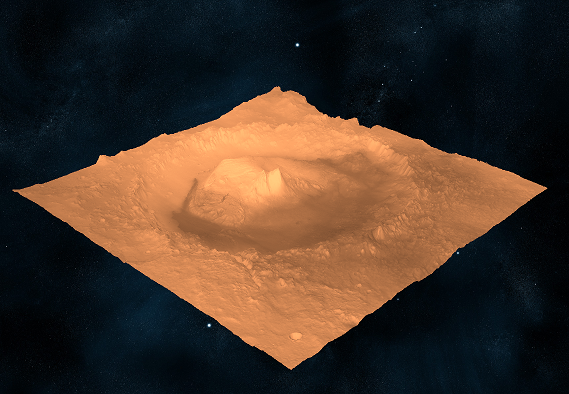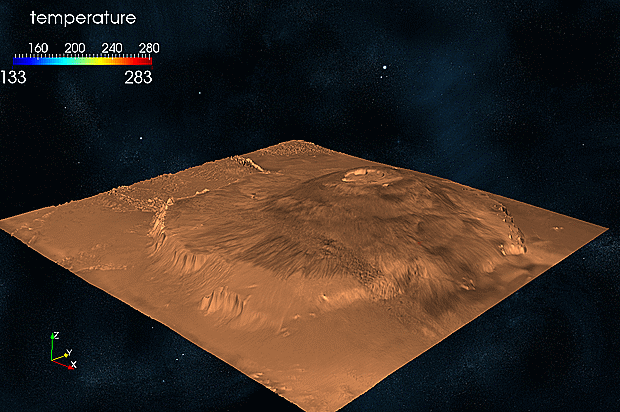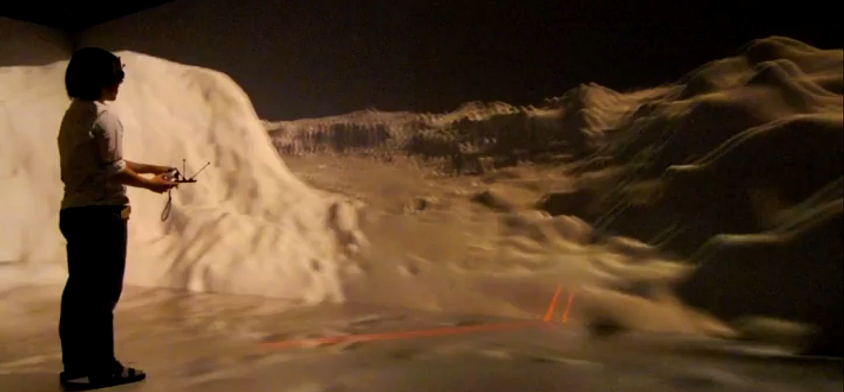Visualisation of Mars Express datasets using Immersive Virtual Reality

Relative to conventional 2D layout, stereoscopic 3D displays have demonstrated to be more efficient and accurate for various depth-related applications, like judgment of absolute and relative distances, spatial manipulation of objects or remote guidance [1].
For the scientist, 3D virtual environments appear to be attractive platforms for the visualisation of large and complex datasets, offering a global and dynamical view of his data while providing a clear and intuitive interface. 3D displays are particularly suitable to investigate wide spatio-temporal data and pinpoint relevant information.
The project
In this project, we explore the possibilities given by immersive virtual reality tools (3D room, Oculus Rift headset) to study the surface and atmosphere of Mars over specific areas like the Gale Crater or the Valles Marineris. For this purpose, we are using ESA's Mars Express (MEX) satellite data freely available on the Planetary Science Archive.

As a first step, high-resolution Digital Terrain Models (DTM) and texture images processed by Die Freie Universität Berlin [2] are merged and processed to be rendered in our 3D visualisation software. We are currently working on adding atmospheric data such as temperature fields as measured by MEX Planetary Fourier Spectrometer (PFS).
We aim at using a state-of-the-art 3D room to further analyse and visualise the results via an ongoing collaboration with Kobe University in Japan [3, 4]. The primary goal of the project is to get insights on the connection between Mars surface topography and the thermal structure and dynamic of its atmosphere.

Oculus Rift virtual reality experience
As an aside to this study, we developed on the occasion of the ESA-ESTEC Open Day 2014 an activity in which we proposed to the public to put on an Oculus Rift headset and embark on a rollercoaster ride through the Gale Crater on Mars. Visitors had thereby the opportunity to discover how it feels to be on Mars. Below you can see a video of this activity:
References
- McIntire, J. P., P. R. Havig, and E. E. Geiselman. 2012. "What is 3D good for? A review of human performance on stereoscopic 3D displays". In SPIE Defense, Security, and Sensing (pp. 83830X-83830X). International Society for Optics and Photonics.
- Gwinner, K., F. Scholten, F. Preusker, S. Elgner, T. Roatsch, M. Spiegel, and C. Heipke. 2010. "Topography of Mars from global mapping by HRSC high-resolution digital terrain models and orthoimages: Characteristics and performance." Earth and Planetary Science Letters, 294(3), 506-519.
- Kageyama, A., N. Ohno, S. Kawahara, K. Kashiyama, and H. Ohtani. 2013. "Immersive VR visualisations by VFIVE Part 2: Applications." International Journal of Modeling, Simulation, and Scientific Computing, 4(supp01).
- Kageyama, A., and Y. Masada. 2013. "Applications and a three-dimensional desktop environment for an immersive virtual reality system." In Journal of Physics: Conference Series (Vol. 454, No. 1, p. 012077). IOP Publishing.